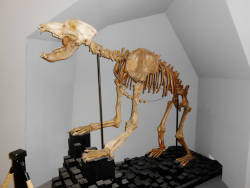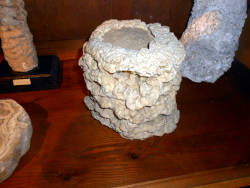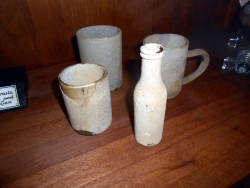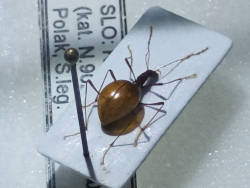Notranjski muzej Postojna
Muzej krasa
Useful Information


| Location: |
In Postojna, Kolodvorska cesta 3.
A1 exit Postojna, turn right, at roundabout again right. From the central place follow road to Planina. About 200 m uphill at Hotel Sport turn right, road to the train station, second building on the left. |
| Open: |
MAY to OCT Tue-Sun 10-18. NOV to APR Tue-Sun 10-17. Closed 01-JAN, 02-JAN, 01-NOV, 25-DEC. [2020] |
| Fee: |
Adults EUR 5, School Pupils EUR 3, Preschoolers (0-5) EUR 1, Students EUR 3, Seniors EUR 3, Disabled free. Groups (10+): Adults EUR 3. [2020] |
| Classification: |
 Museum Museum
|
| Light: |
 Incandescent Incandescent
|
| Dimension: | Ar=700 m². |
| Guided tours: | available after appointment |
| Photography: | allowed |
| Accessibility: | yes, well equipped |
| Bibliography: |
Alma Bavdek, Alenka Čuk, Valentin Schein, Marjetica Simoniti (2020):
Predjamski zaklad, the Predjama Treasure Cache,


Alma Bavdek, Alenka Čuk (2017): Muzej je Vaš. 70 let Notranjskega muzeja Postojna 
|
| Address: |
Notranjska Museum Postojna, Kolodvorska cesta 3, 6230 Postojna, Tel: +386-572-11090.
E-mail: |
| As far as we know this information was accurate when it was published (see years in brackets), but may have changed since then. Please check rates and details directly with the companies in question if you need more recent info. |
|
History
| 1950 | museum founded by Leo Vilhar. |
| 1974 | transformed into the Karst Museum Collection within the Karst Research Institute of the Slovenian Academy of Sciences and Arts. |
| 1990 | transformed into an independent institution, the Notranjska Museum Postojna. |
| 2010 | the municipality enabled the Museum to start operating in new premises. |
| 26-FEB-2015 | the permanent museum exhibition on karst - the Karst Museum - part of the museum. |
Description


There has always been a karst museum at Postojna, famed by cavers and other visitors, often closed for political reasons, then reopened, restructured, whatnot. If you went to Postojna during the Yugoslavia era, the museum was located beneath the tourist office at the town square. There were always others who had seen it, but it was always closed when I was there. Then it moved a few buildings up the road, where it was located for decades, but still always closed. At least there was now a sign at the door, and it is still marked in Google Maps at this location [2020]. But today the museum is reopened in a newly renovated building which is located further up the road and then right at the Hotel Sport.
Notranjska is an old Slovenian name for this area, the Austrians later called it Unterkrain (Lower Carniolia). This museum is dedicated to the area around Postojna, its people, its history, its culture, its geography and geology. So it is not a museum about the caves, it’s a local history museum. But as much of the local history is strongly related to a cave in one way or another, it actually is about caves. And there was Muzej krasa - Karst Museum, an exhibition about the cultural history of karst exploration. The exhibition once even had its own website, but its gone and only one of those annoying facebook pages remains. And there is an archive section on the museum webpage.
The museum will show you a lot of history about the Notranjska area. How people lived for centuries as farmers, how the country was owned by various foreigners until 1990. How it was at the frontier during two world wars and in between. Its departments are archaeology, biology, ethnological, history, conservation and restoration, and the pedagogical department. But it also has exhibits about caving and which clothes and equipment is needed, with a really impressive diorama of a caver. It explains how the karst struggles for its drinking water supply.
This museum is obviously the museum intended for the locals, not for the millions of tourists. As such it is free for citizens of Postojna and the main language in the museum is Slovenian. Nevertheless, it is worth a visit. And it uses modern technology, so install the NEXTO app and you will get a guided tour in Slovenian, English, or Italian. It offers in depth information, explanatory podcasts, and even additionally support for disabled.
 Official Website Replaced by Facebook Page
Official Website Replaced by Facebook Page Search DuckDuckGo for "Notranjski muzej Postojna"
Search DuckDuckGo for "Notranjski muzej Postojna" Google Earth Placemark
Google Earth Placemark Notranjski muzej Postojna, official website
Notranjski muzej Postojna, official website  Index
Index Topics
Topics Hierarchical
Hierarchical Countries
Countries Maps
Maps